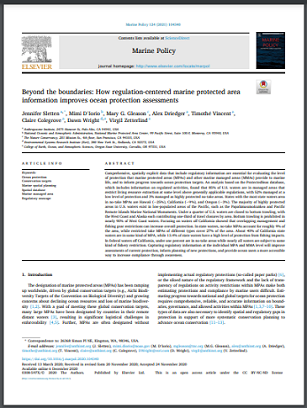
Comprehensive, spatially explicit data that include regulatory information are essential for evaluating the level of protection that marine protected areas (MPAs) and other marine managed areas (MMAs) provide to marine life, and to inform progress towards ocean protection targets. An analysis based on the ProtectedSeas database, which includes information on regulated activities, found that 85% of U.S. waters are in managed areas that restrict living resource extraction at some level above generally applicable regulations, with 52% managed at a low level of protection and 3% managed as highly protected no-take areas. States with the most state waters area in no-take MPAs are Hawaii (~25%), California (~9%), and Oregon (~3%). The majority of highly protected areas in U.S. waters exist in low-populated areas of the Pacific, such as the Papahanaumokuakea and Pacific Remote Islands Marine National Monuments. Under a quarter of U.S. waters are closed to bottom trawling, with the West Coast and Alaska each contributing one-third of trawl closures by area. Bottom trawling is prohibited in nearly 90% of West Coast waters. Focusing on waters off California showed that overlapping management and fishing gear restrictions can increase overall protection. In state waters, no-take MPAs account for roughly 9% of the area, while restricted take MPAs of different types cover 27% of the area. About 40% of California state waters are in some kind of MPA, while 13.4% of state waters have a high level of protection from fishing impacts. In federal waters off California, under one percent are in no-take areas while nearly all waters are subject to some kind of fishery restriction. Capturing regulatory information at the individual MPA and MMA level will improve assessments of current protection, inform planning of new protections, and provide ocean users a more accessible way to increase compliance through awareness.














